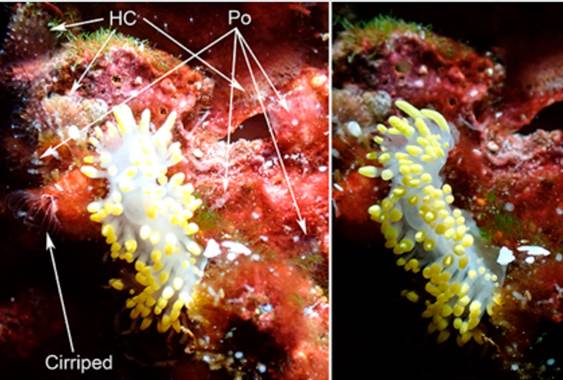Nudibranchs are one of the most species-rich groups of mollusks (Dinapoli and Klussmann-Kolb, 2010). According to Wägele and Willam (2000), this is the most outstanding group within the Heterobranchia, reaching about 3000 species. Despite this, new species are continuously discovered worldwide (e.g., Hermosillo and Valdés, 2007; Valdés et al., 2018; Pola et al., 2019; Korshunova et al., 2020; Neuhaus et al., 2021). The heterobranch fauna of Colombia is poorly known. Ardila et al. (2007) reported 109 species for the country (80 species exclusive to the Caribbean, 26 species exclusive to the Pacific, and 3 species common to both coasts). Recently, Londoño-Cruz (2021), using published and new records, updated to 103 the number of known species of Heterobranchia for the Pacific coast of Colombia, totalling 186 species for the country. According to these recent records the heterobranch biodiversity appears to be greater in the Pacific (55.4%) compared to the Caribbean (44.6%) coast. The apparent inconsistencies in the species richness data are a reflection of the need for more exhaustive research on this group of organisms in Colombia.
In December 7, 2021, Mr. Feng Zhan photographed a specimen of an apparently unknown nudibranch when diving at Davies rock (southwest corner of Malpelo Island - Figure 1). According to the external morphology and coloration, the specimen was identified as Cuthona behrensiHermosillo & Á. Valdés, 2007 (Mollusca: Heterobranchia: Nudibranchia: Cuthonidae, Figure 2). The species had been officially recorded only once in the Tropical Eastern Pacific (in the original description), so this is the second documented record of this species and confirms its presence in the area. According to the information provided by the diver, the specimen had an approximate length of 15 mm, was found on a vertical rocky wall exposed to strong currents at a depth between 25 and 35 m and moved very slowly. Contrasting with Hermosillo and Valdés (2007), the specimen from Malpelo Island is, at least, twice as large and was found at a deeper range than the holotype. The substrate where the specimen was found consisted of a complex matrix of red, green and crustose coralline algae. In the protographs, hydroid colonies (HC) and polyps (Po) (a probable prey item?), as well as barnacles’ cirri are also visible (Figure 2). That the species dwells in sites with strong currents or wave action and that might prey on hydrozoans was also reported by the describing authors.

Figure 1 Location of Malpelo Island (red mark) on the Tropical Eastern Pacific showing Davies rock where the C. behrensi was photographed. The site of the original description is also shown (blue mark).

Figure 2 In situ photographs of Cuthona behrensi. HC: Hydroid colonies, Po: Polyps. Photopraph by Mr. Feng Zhan.
The photographed specimen, with very few differences, is morphologically identical to the one described by Hermosillo and Valdés (2007). The rhinophores are long and smooth, with rounded apices and constant diameter throughout their length. The body, as well as the bases of the rhinophores, are translucent bright white. The apical two-thirds of the latter are bright yellow. The oral tentacles have the same coloration and pattern as the rhinophores. The cerata also have the same coloration, but the yellow portion is shorter, from one-third to half the length of each ceras. Although difficult to state with certainty, it seems that the number of cerata is, at least, twice the number reported for the holotype, this might be due to the difference in size.
The identification of the photographed specimen was confirmed by Dr. Hans Bertsch and Dr. Ángel Valdés. The latter along with Dr. Alicia Hermosillo described the species. This report extends the distribution range of the species almost 400 km southward, and the depth range goes down to ca. 30 m. Finally, the number of heterobranch species for Malpelo Island reaches 49 with a total of 104 for the Colombian Pacific.











 text in
text in 



